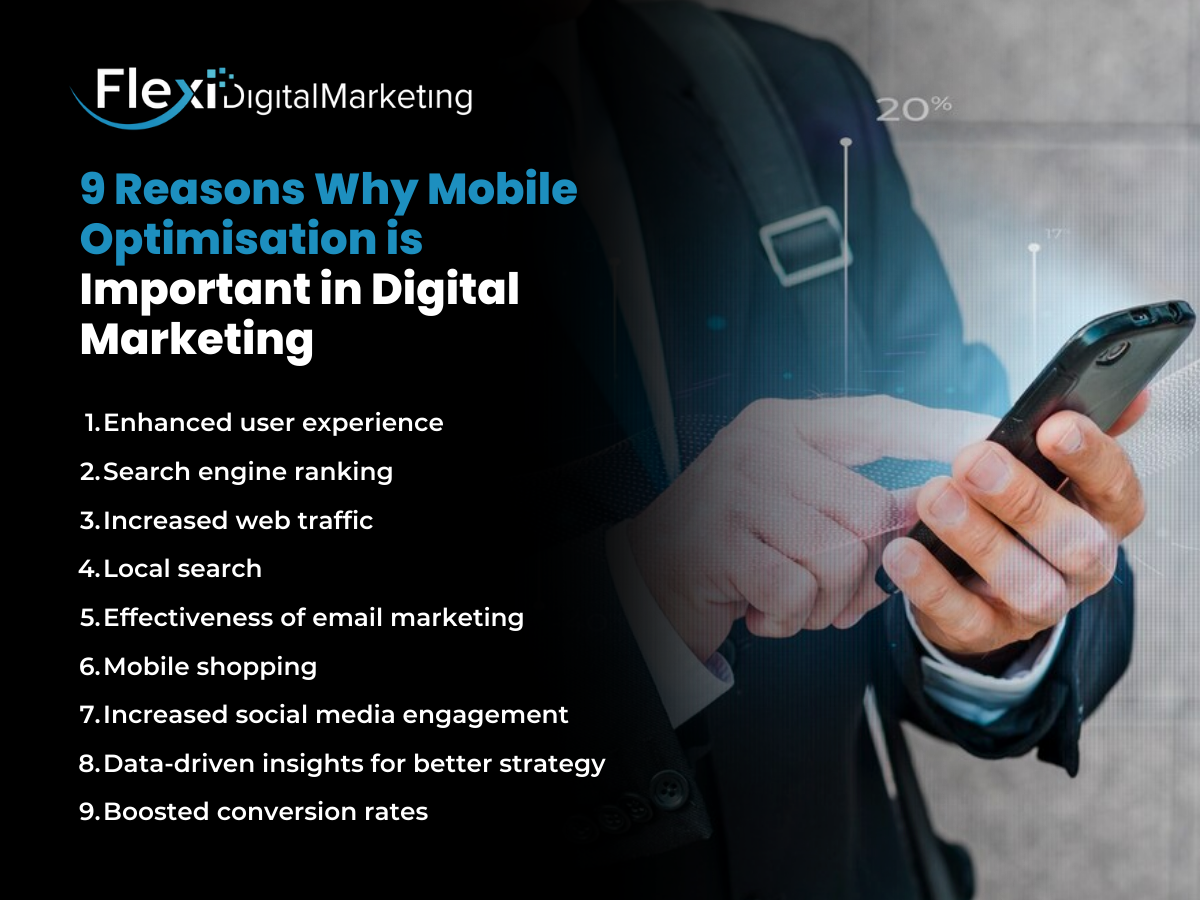So, picture this: you are scrolling through your phone, looking for restaurant recommendations for your date. And when you open their site to make a reservation, boom! The website is in shambles and hard to navigate. Sound familiar? That’s why mobile optimisation is essential today.
With the increasing use of mobile devices, it is crucial for businesses to prioritise mobile optimisation. This is to enhance user experience, improve search engine ranking, increase web traffic, and drive conversions. In this blog, we will explore the importance of mobile optimisation in digital marketing and discuss nine key reasons businesses must invest in mobile optimisation efforts.
What Is Mobile Optimisation in Digital Marketing?
Mobile optimisation, also known as mobile optimisation, refers to the process of ensuring that website content, design, and functionality are optimised for mobile devices. It involves creating responsive web pages that adapt to different screen sizes, providing a seamless mobile experience for users.
In digital marketing, mobile optimisation aims to make the user experience seamless, intuitive, and enjoyable for individuals who interact with digital content on their mobile devices. This may involve implementing responsive web design, optimising loading times, streamlining navigation, and prioritising mobile-friendly features and functionalities.
9 Reasons Why Mobile Optimisation is Important in Digital Marketing
With the rising number of mobile users, mobile optimisation has become a critical aspect of digital marketing. Statista projected a cumulative rise of 910.3 million smartphone users globally from 2023 to 2028.
With that said, marketers must understand the significance of mobile optimisation to stay ahead in the digital landscape.

Enhanced user experience
Think about it this way: when browsing the web on your phone, what's the one thing you want more than anything? Speed and ease, right? That's where mobile optimisation comes in.
Enhanced user experience is one of the primary reasons for investing in mobile optimisation in digital marketing. It ensures that users can navigate the website easily, with pages loading quickly and functionality intact. A responsive website design adapts to the user's device, making it easy to read content, view images, and interact with the website's features.
With that in mind, businesses can increase user engagement, reduce bounce rates, and improve overall customer satisfaction.
Search engine ranking
Another significant reason to prioritise mobile optimisation in digital marketing is its impact on search engine ranking. Search engines like Google consider mobile optimisation a ranking factor, favouring mobile-friendly websites. Mobile SEO techniques, including mobile site speed, responsive design, and mobile-specific meta descriptions, improve search results visibility.
With a mobile-optimised website, businesses can reach a wider audience and increase their chances of appearing higher in search engine results, leading to more organic traffic and potential customers.
Increased web traffic
Have you ever stumbled upon a website that looks straight out of the Stone Age and takes forever to load? Frustrating, isn’t it? We know that as a user, you instead stick around on a site that loads faster.
That's the magic of mobile optimisation when it comes to driving web traffic. Mobile optimisation in digital marketing typically involves optimising images, reducing file sizes, and improving code efficiency, all of which contribute to faster loading times on mobile devices. Faster loading times not only enhance the user experience but also reduce bounce rates and improve search engine ranking, ultimately leading to increased web traffic.
Local search
Picture this: you're craving pizza, so you pull out your phone and type in "pizza near me." Boom! The first thing that pops up is a slick, mobile-friendly website for a pizza joint just around the corner. Buttons are easy to tap, the menu is crystal clear, and you can practically smell the pepperoni through the screen.
Now, that's how mobile optimisation in digital marketing can help. With the widespread use of smartphones, a significant portion of local searches is performed on mobile devices. People often search for nearby businesses, restaurants, services, and attractions while on the go using their smartphones. Suppose a website is not optimised for mobile. In that case, it may not appear correctly or be challenging to navigate on smaller screens, leading to a poor user experience and potentially causing users to abandon the site.
Effectiveness of email marketing
When it comes to email marketing, mobile optimisation is a must. Pictures this: you're scrolling through your emails on your phone, trying to make sense of a message that looks like it was designed for a computer screen from the Stone Age. Not precisely enticing, right?
Today, a significant portion of email opens occur on mobile devices. Many people check their emails on smartphones and tablets throughout the day. If an email is not optimised for mobile, it may display poorly on smaller screens, making it difficult for recipients to read and interact with the content.
And here's the deal: when your emails look great and function smoothly on mobile devices, you'll likely catch people's attention. Buttons are easy to tap, images load quickly, and text is excellent and readable – all crucial ingredients for getting your message across effectively.
Mobile shopping
We all do our shopping mostly on our phones. We use our mobile devices to browse, add to our cart, buy, and deliver our latest obsession right to our doorstep with just a few taps. Now, imagine this: you're itching to snag the perfect pair of shoes, but when you visit a website on your phone, it's like navigating a maze blindfolded. Not exactly the smooth shopping experience you were hoping for, right?
This is why mobile optimisation in digital marketing is essential. Mobile shoppers can browse products, compare prices, and make purchases anytime and anywhere, whether commuting, waiting in line, or relaxing at home. With that, retailers cater to the needs of busy consumers who value convenience and flexibility, driving sales and fostering customer loyalty.
Increased social media engagement
Have you ever witnessed yourself scrolling through your social media and saw a post that piques your interest? Then, when you click the website attached to it, you are faced with a website with tiny text and wonky images. Not exactly inspiring, right
Most social media users use mobile devices to access platforms like Facebook, Instagram, Twitter, and TikTok. Mobile optimisation in digital marketing ensures that content shared on social media platforms appears correctly and is easily accessible on smartphones and tablets. Without mobile optimisation, content may appear distorted or complex to view on mobile screens, leading to decreased engagement and missed opportunities to connect with audiences.
Data-driven insights for better strategy
Here's the deal: mobile optimisation ensures your data isn't biased or incomplete. When your website or app looks and functions seamlessly on mobile devices, you can collect accurate, comprehensive data that reflects how real users interact with your brand.
And here's where it gets fascinating. With this data, you can uncover valuable insights that inform your strategy. You may discover that users are bouncing off a particular page on your website because it's not loading correctly on mobile. Or you may find that a specific feature in your app drives much engagement among mobile users. These insights help you make informed decisions about where to invest your resources and how to optimise your digital presence for maximum impact.
Boosted conversion rates
Now, picture this: you've got an excellent product or service and a killer marketing strategy, but when users try to make a purchase on their phone, they hit a roadblock because your website isn't optimised for mobile. Ouch, right?
Mobile optimisation in digital marketing is essential for boosting conversion rates. It improves the user experience on mobile devices, capitalises on mobile traffic growth, utilises responsive design techniques, facilitates local and on-the-go conversions, and enhances search engine visibility. Businesses can remove barriers to conversion and create a seamless and engaging experience for mobile users, ultimately driving higher conversion rates and improving overall business performance.
Conclusion
In summary, mobile optimisation is no longer just an option; it has become necessary in digital marketing. With the increasing number of mobile users, businesses must ensure that their websites, emails, and content are optimised for mobile devices.
Mobile optimisation enhances user experience, improves search engine rankings, increases web traffic, and boosts conversion rates. It allows businesses to tap into the potential of local search, effectively utilise email marketing, and engage with customers through mobile shopping. Moreover, mobile optimisation provides valuable data-driven insights to help businesses refine their marketing strategies.
If you want to stay ahead in the digital marketing game, it's time to prioritise mobile optimisation. Book a free consultation with our experts to learn more about how mobile optimisation can benefit your business.


